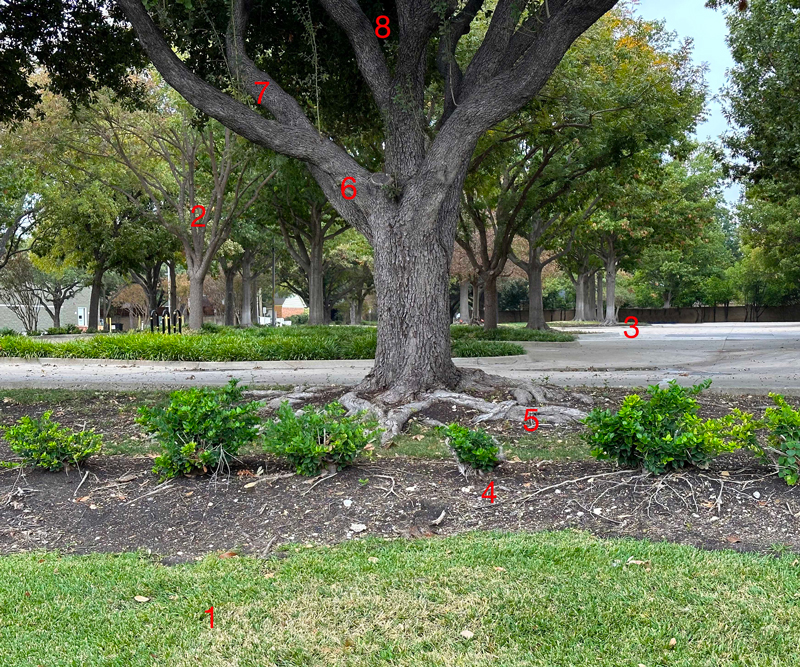How Many Things We Can Talk About
So here is my expanded photo with the numbers superimposed. One of them was what first caught my eye. I’ll tell you when we get to it.
1. First signs of brown patch. See the St. Augustine turning yellowish-brown? (More brown than yellowish.) Just to the right of the “1.” It’s a fungal disease (now also being called “large patch”) that impacts the blades. If I’d pulled on them, they would have come loose easily from the runners and you could have seen the deteriorated tissue. Left untreated the grass will continue to go downhill. Then it will gradually come back. It only impacts the blades – not the runners or roots. You can stop it with a labeled turf fungicide. Plus, stop watering in the evenings. Moisture and cooling temperatures bring on the brown patch.
2. Although I could be wrong, it looks like this tree might have suffered from sudden limb drop. Remember when I showed you that on our large red oak a few weeks ago? It happens during periods of heat and drought when humidity causes the brittle wood to take on moisture, gain weight and suddenly almost to “explode” off the tree. Here’s a link back to that story.
3. Root flare is exposed on these trees. This is ideal. It shows that the trees were planted at the correct depth. Some people may not like to see the roots like that, but certified arborists will tell you this is best for the long-term vigor of the trees. You don’t want to see a trunk heading straight down into the ground without any of the broadening of the flare visible.
4. Freeze damage still visible from February 2021. I think these are waxleaf ligustrums. I don’t believe they’re hollies. Waxleafs were really hurt by that cold spell. My guess is that this is growth that was beneath the snow line. My point in showing it is that it’s probably time to consider replacing them. But that’s not my call to make. I do understand budgets. These folks have done a nice job on the rest of their landscape, so they don’t need my opinions.
5. More root flare showing the mass of surface roots you have to expect from live oaks. This was actually what prompted this photo. You can see a couple of roots crossing over one another, one of them to the left of the “5” and the other wrapping against the right side of the trunk. A certified arborist will know how to remove those for the long-term health of the tree. Someone is taking good care of these trees. I’ll bet they’ll get this handled.
6. A major branch has been removed, perhaps after it broke in an ice or windstorm. This photo is from a corridor where wind did a great deal of damage a couple of Junes ago. Notice that the branch collar was left and that the cut surface was sealed with pruning paint. It is already healing properly.
7. This tree (and the others) have been thinned and cleaned out to get more light to the grass and landscape below. I’m sure the next time the arborists are on site they will remove these strong vertical shoots. They serve no purpose. They can be removed at any time.
8. This part of the tree looks congested. I may be wrong, but it looks like branches may be rubbing against one another. Again, a good tree service crew has apparently been caring for these trees, so I’d guess that all is well here, but this is one place I’d have them look. And there are more of the sprouts visible up in this area, too.
So that’s what I found in my 5-second photo. I really wanted something meaningful to share with you, but it’s been tough getting all my homework assignments turned in. Lynn and I were on our way to my every-90-day appointment with my dermatologist, and this is what I got done on the way. I hope it was helpful.

